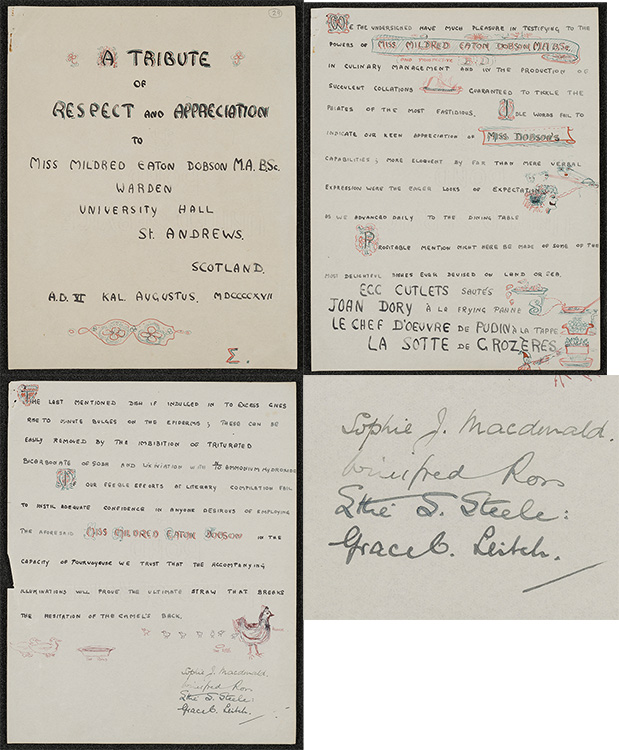International Day of Women and Girls in Science – Chemistry at St Andrews
The United Nations International Day of Women and Girls in Science is observed on the 11th of February each year to promote equal access to Science, Technology, Engineering and Mathematics (STEM) fields. This year, we highlight some of the early women in the subject of Chemistry at the University of St Andrews.
The L.A. (Literate in Arts) scheme, later the L.L.A. (Ladies Literate in Arts) began in 1877. The distance learning qualification offered women the title of L.A. after passing the requisite examinations and paying the required fee. The initial intention of the scheme was that the certificate would ‘be of great use to women who propose to become teachers.’ The subject of Chemistry was offered as part of the qualification, the first student to sit the Chemistry paper being Jessie Scott Fergusson in 1882. The exam paper for the year is as below. The exam covers topics such as inorganic and organic chemistry, crystallography, the history of chemistry, and chemical engineering.
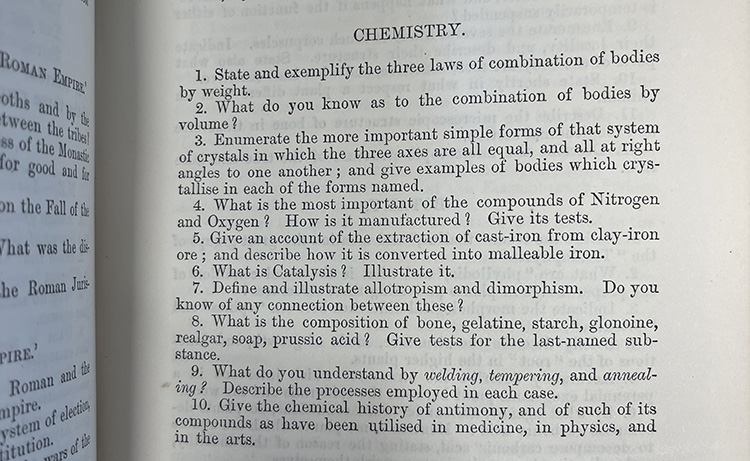
The University of St Andrews Lecture-Extension Scheme provided various University level courses in local communities to be taught by university lecturers or recent graduates. From the first annual report of the scheme in 1889, the following courses in Chemistry were on offer. The lecture course was open to all who could pay the fee and there was the option to attend additional seminars with an end of course examination. Some of the surviving examiner’s reports list the names of the women in St Andrews, Cupar and Kinghorn who attended.
From the First Annual Report University of St Andrews Lecture-Extension Association, 1889 (UYUY470)
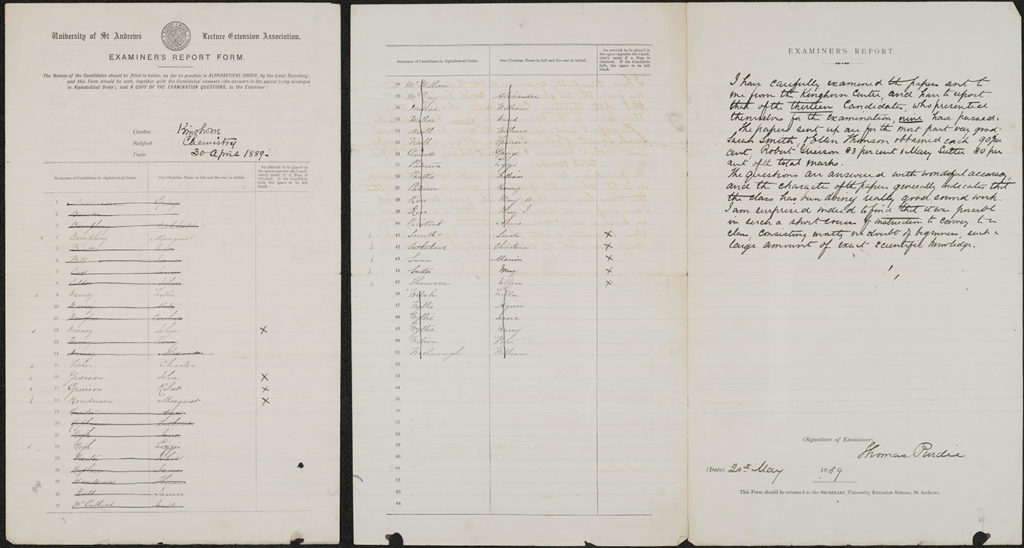
The Universities’ (Scotland) Act of 1889 enabled women to be enrolled into ordinary day classes alongside men. Women began enrolling in classes at St Andrews from 1892. The first women to attend Chemistry classes in the academic year 1892-1893 were:
1892-93 United College, St Andrews
- Janet Dorothy Gilfillan, London
1892-1893 University College, Dundee
- Agnes Blackadder, Broughty-Ferry
- Bessie Hamilton, Dundee
- Christina H Stirling, Perth
Janet Dorothy Gilfillan went on to study in Edinburgh and qualified as a doctor (MB ChB 1898). Agnes Blackadder may be well-known to most as the first women to graduate at St Andrews in 1895. She went on to qualify as a doctor from Glasgow in 1898 (MB ChB) and practiced as Agnes Savill.
Thomas Purdie became Professor of Chemistry in 1884. Purdie was responsible for the chemistry building (now the Irvine building). At first a one-storey building, the laboratory was extended and further equipped by Purdie to become a research institute occupied by eighteen graduate researchers in 1905.
One of Purdie’s students, James Irvine, would become lecturer in 1902, Professor in 1909 and Principal of the University in 1920. During both Purdie and Irvine’s time, a number of women undertook research in the Chemistry research laboratory.
Agnes Marion Moodie (1881-1969) from Arbroath was the daughter of Robert Moodie, founder of the Edinburgh Mathematical Society. She received an MA in 1902, a BSc in 1903 and BSc honours in 1904. Moodie remained at St Andrews on a Berry Scholarship in 1905 and as a Carnegie scholar in 1907. In the collections we have her research application and chemistry lab notebook in which she describes her research on the rotational dispersion of the sugar groups, contributing to the general topic of carbohydrate chemistry, which was pioneered by Purdie and Irvine and gave St. Andrews international recognition in the first quarter of the 20th century.
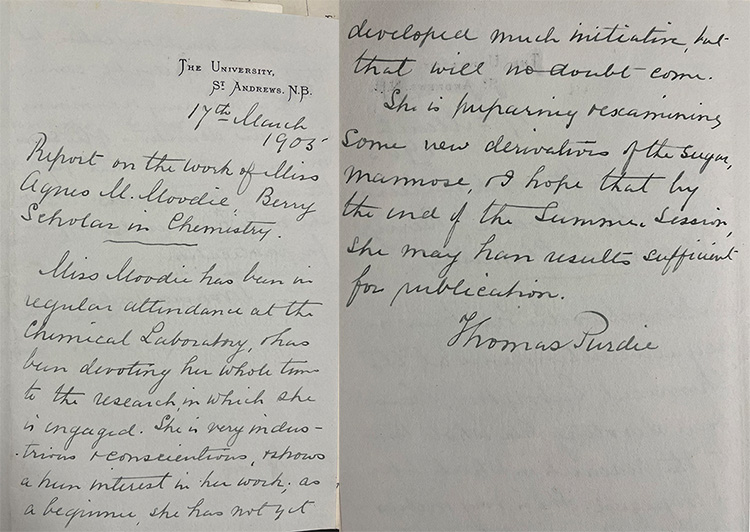
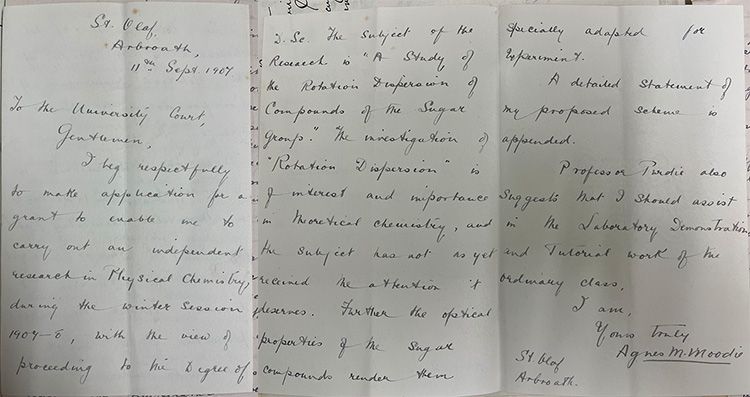
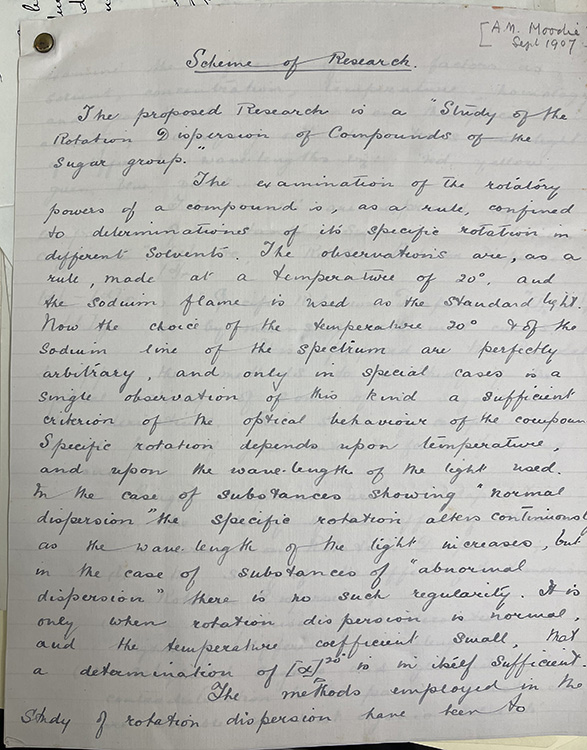
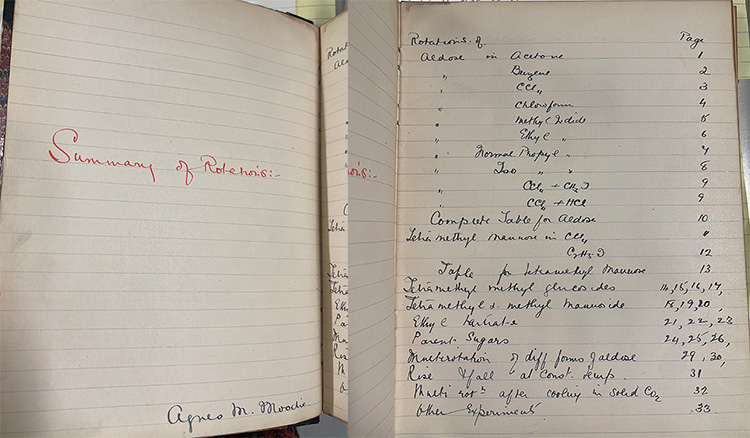
Moodie’s contemporary, Elizabeth McIndoe Eilly Scoular, from Cupar, received an MA and BSc, completing the final BSc examination in Chemistry in October 1904 along with Moodie. Also a Berry Scholar, she went on to be a secondary school science teacher. In a letter to Andrew Bennett, University Secretary, Scoular describes her research while at the University, on the general subject of alkylation.
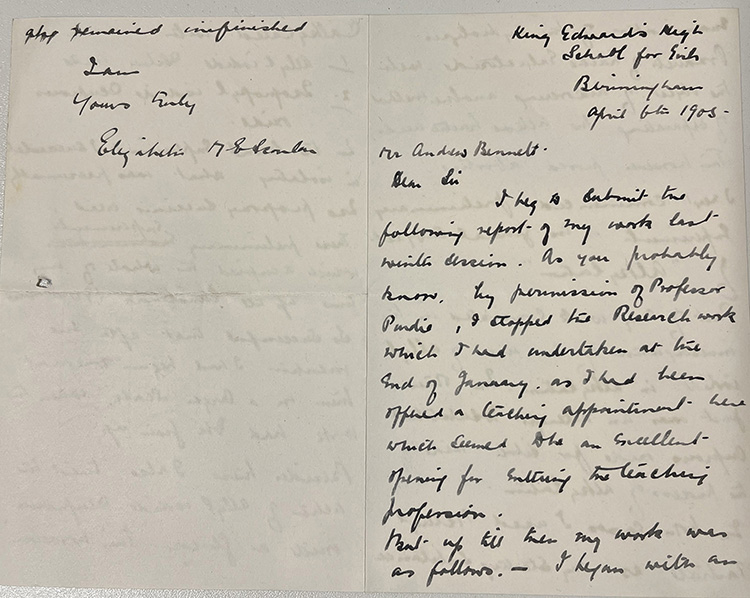
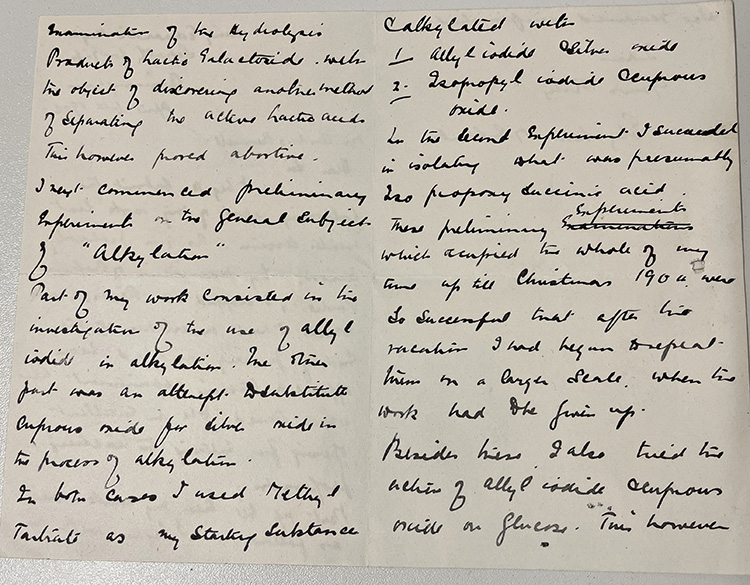
Moodie was resident in University Hall from 1904-1908 and Elizabeth M E Scoular from 1899-1904. While we cannot definitively identify them, there is the possibility they are featured in these University Hall group photos from 1902-1903 and 1908-1909 respectively.
Further University Hall residents were Ettie S. Steele, Grace C. Leitch and Winifred Ross.
Ettie Stewart Steele, received her MA from St Andrews in 1912 and a BSc in 1914. She was the first women to be a University Assistant, being appointed in Chemistry in 1916 and was the first candidate to submit a thesis for the new degree of PhD in 1919. Her research was carried out in the Chemical Research Laboratory under the direction of Irvine and took 19 terms (1914-19). She lived in University Hall from 1897-1901 and 1908-1930. She was the first women to serve as lecturer in Chemistry (1920) and was warden of Chattan House, later McIntosh Hall, from 1930-59. She worked closely with Principal Irvine in both research and administration, acting as his secretary. In retirement she became ‘bursar of residences’. The School of Chemistry named a reading room after Dr Steele.
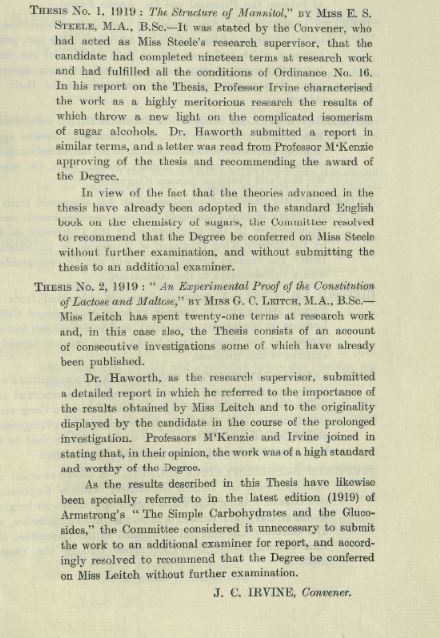
Steele graduated with Dr Grace Cumming Leitch as the earliest PhDs in 1920. Grace C. Leitch (1889-1942), from Cupar, alongside Steele, served as a research assistant in the Chemistry lab from 1918. Leitch undertook her research alongside lecturer Norman Haworth. Haworth was appointed as Professor of Chemistry at Armstrong College, Newcastle in 1920. Leitch was soon to follow and was appointed lecturer in Chemistry at Armstrong College (University of Durham). Leitch later joined the research group of George Clemo, co-authoring papers on alkaloids.
A fellow University Hall resident, Winifred Ross, Dundee MA 1912, BSc 1914, was also a research student and Carnegie Scholar and served as assistant in Chemistry in 1917. In the University Hall archive there is a tribute to the warden Mildred Dobson, signed by Ross, Steele, Leitch and fellow Chemistry research student Sophie Jane MacDonald (or Wilkie) from Perth.
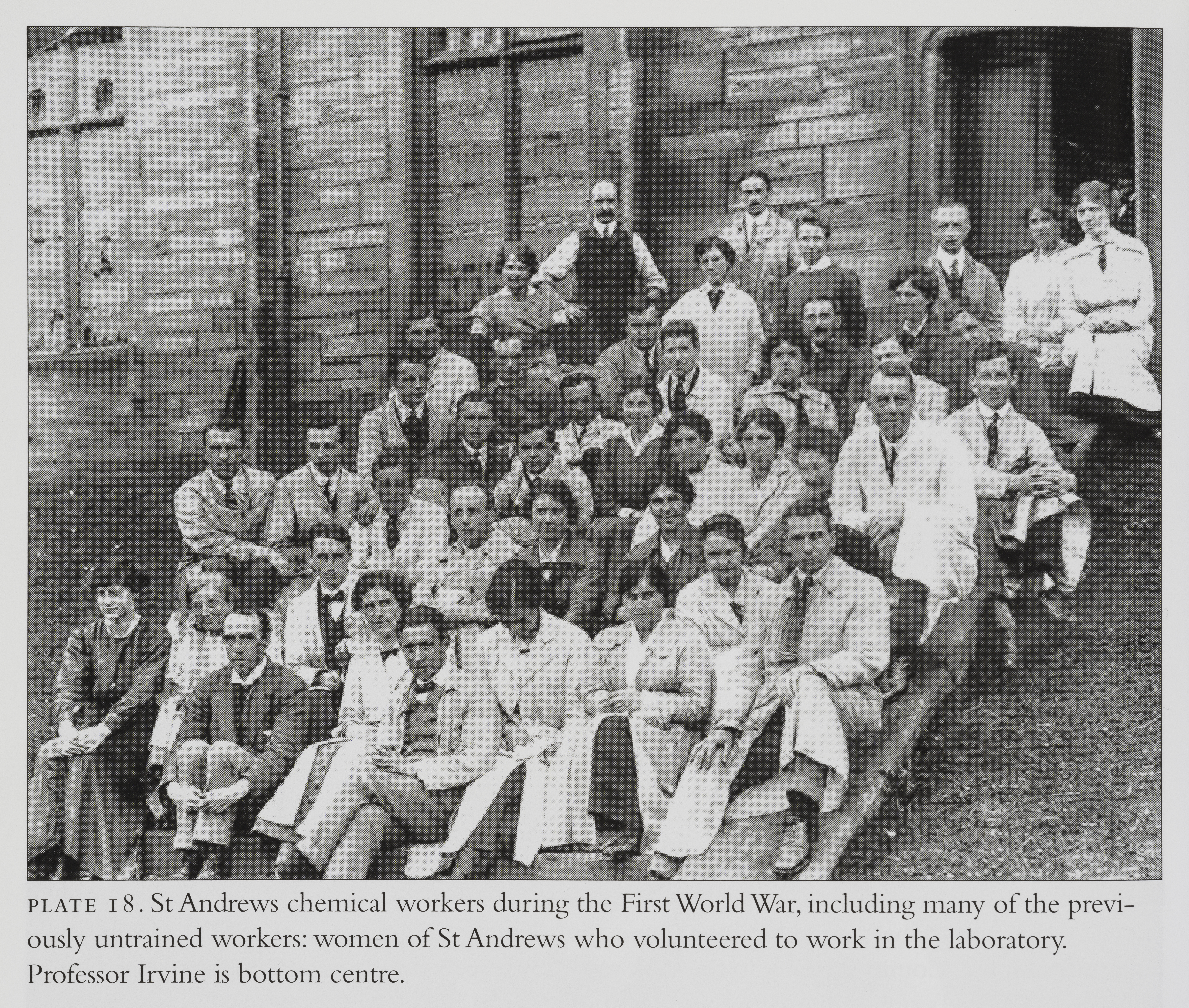
During the First World War, the work of the department was interrupted by the war effort. The Chemistry lab become a factory with workers including students, graduates, and local women from St Andrews. A report by Irvine on the work carried out can be found in the records of the University Court for the academic year 1915-1916. Working in the lab in the vacation period there were three members of staff, 13 research students, 10 staff and students and 12 workers without connection to the University.
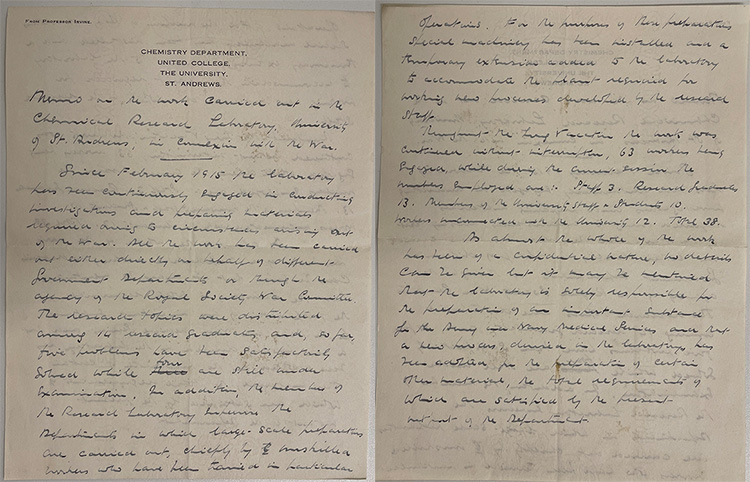
In an Alumnus Chronicle article of 1978, a former student M.E.O. (potentially Marjorie Eleanor Osman, MA 1916) reflected on Irvine and her experiences during the war.
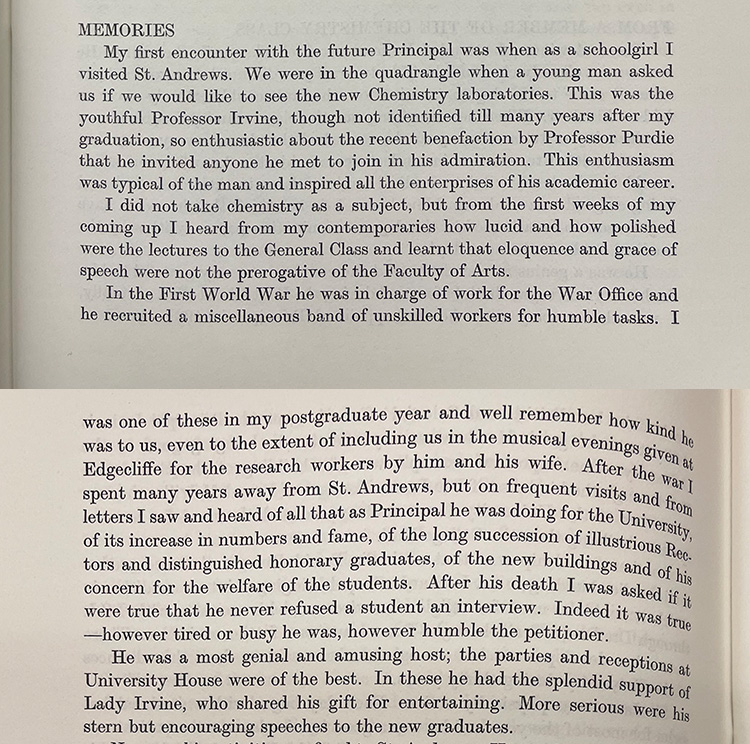
This blog is by no means a comprehensive history of early women working in Chemistry at St Andrews but hopefully provides a snapshot into some of the first women studying and researching in one of the STEM fields at St Andrews.
A display of books relating to Women in Science is now available in the Main University Library.
Further reading:
Chemistry was their life : pioneer British women chemists, 1880-1949, by Marelene Rayner-Canham, Geoff Rayner-Canham (2008).
